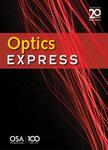版权所有:内蒙古大学图书馆 技术提供:维普资讯• 智图
内蒙古自治区呼和浩特市赛罕区大学西街235号 邮编: 010021

作者机构:National Laboratory of Solid State Microstructures College of Engineering and Applied Sciences Institute of Optical Communication Engineering Nanjing University Key Laboratory of Intelligent Optical Sensing and Manipulation The Ministry of Education Nanjing210093 China Ocean College Jiangsu University of Science and Technology Zhenjiang212003 China
出 版 物:《Optics Express》 (Opt. Express)
年 卷 期:2025年第33卷第3期
页 面:6304-6318页
核心收录:
学科分类:080705[工学-制冷及低温工程] 0810[工学-信息与通信工程] 070207[理学-光学] 0809[工学-电子科学与技术(可授工学、理学学位)] 07[理学] 08[工学] 0807[工学-动力工程及工程热物理] 0803[工学-光学工程] 0812[工学-计算机科学与技术(可授工学、理学学位)] 0702[理学-物理学]
基 金:National Natural Science Foundation of China (62090050, 62404098, 62204231) .National Key Research and Development Program of China (2023YFB2806400, 2021YFB2801902, 2018YFB2201801) Natural Science Foundation of Jiangsu Province of China (BK20241196)
主 题:Semiconductor optical amplifiers
摘 要:In this paper, an ultra-wideband distributed feedback (DFB) laser array with matrix grating based on the enhanced self-heating effect is proposed and experimentally demonstrated. 12 lasers are monolithically integrated with a 4 × 3 matrix style with a wavelength spacing of 5 nm. The reconstruction-equivalent-chirp technique is used to simplify the grating fabrication and enhance the precise control of the wavelength spacing. A cascaded Y-branch sharing identical active layers with the lasers is used to realize one waveguide output, which only requires a small current to compensate for the material absorption. This can reduce fabrication complexity compared to using the butt-coupling technique. A semiconductor optical amplifier (SOA) is integrated in front of the laser array to amplify and adjust the optical power. By optimizing the doping concentration of the p-waveguide region, the self-heating effect of the DFB laser has been enhanced, thereby increasing the wavelength current tuning range of a laser unit. As a result, the wavelength of the laser array is precisely controlled, with the wavelength deviation of all 12 lasers maintained within ±0.2 nm. The wavelength current tuning range of a DFB laser unit reaches 5.8 nm. Consequently, without adjusting the thermoelectric cooler (TEC), the laser array can achieve a continuous wavelength current tuning range of up to 60 nm. After SOA amplification, the output power of the laser array is above 55 mW, and the relative intensity noise (RIN) is lower than -130 dB/Hz. Additionally, its side-mode suppression ratio (SMSR) is greater than 45 dB, indicating excellent single-longitudinal-mode properties. The proposed tunable laser is considered highly advantageous for dense wavelength-division multiplexing (DWDM) systems and optical sensing systems. © 2025 Optica Publishing Group under the terms of the Optica Open Access Publishing Agreement.